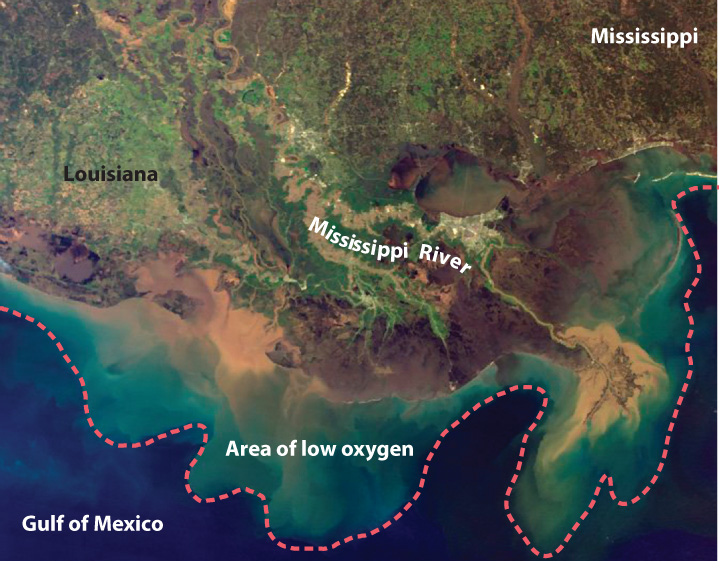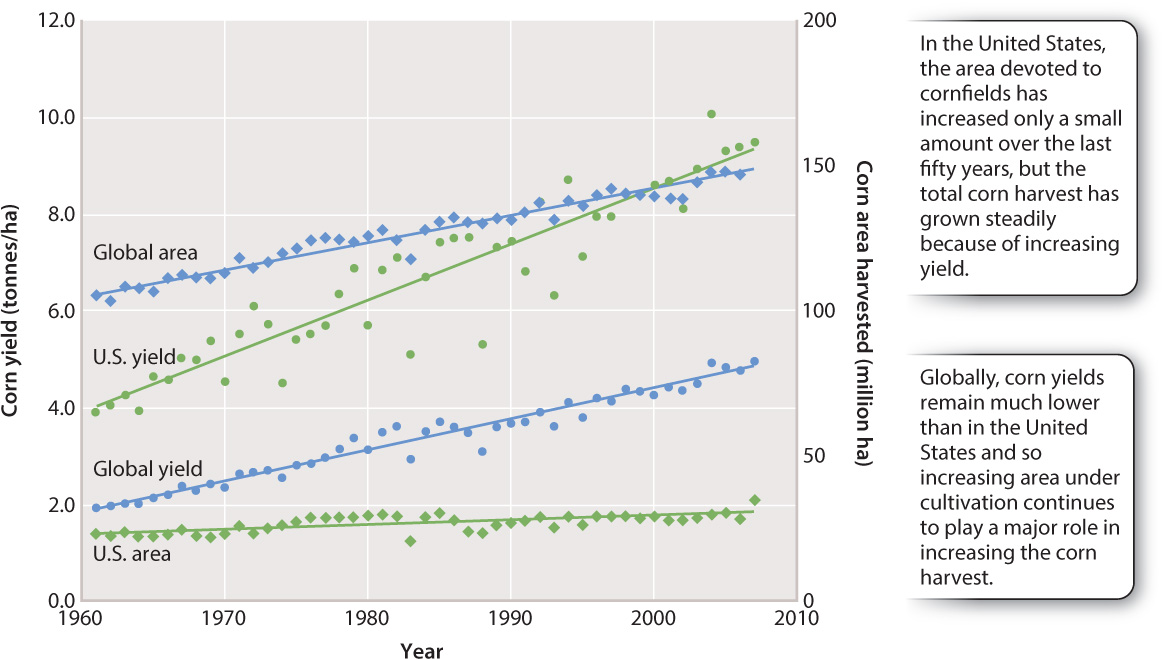48.3 HUMAN INFLUENCE ON THE NITROGEN AND PHOSPHORUS CYCLES
Human activities influence the environment not because we operate outside the carbon cycle, but because we have become an important part of it. Our interest in improved crop production also results in unprecedented human impact on the nitrogen and phosphorus cycles. Once again, environmental changes tied to human nitrogen and phosphorus use are altering the ecological landscape for species in lakes and the sea.
48.3.1 Nitrogen fertilizer transported to lakes and the sea causes eutrophication.
As discussed in Chapter 26, all organisms require nitrogen to synthesize proteins, nucleic acids, and other molecules. Although nitrogen is plentiful in the atmosphere as N2 gas, this form is not biologically available to animals and plants. As we saw in Chapter 26, bacteria and archaeons are able to convert N2 to biologically available forms of nitrogen, called fixed nitrogen, such as ammonia (NH3) and nitrate (NO3−). Plants then obtain nitrogen from ammonia and nitrate in the soil, and animals get the nitrogen needed for growth from the food they eat. Crops, harvested year after year in the same fields, deplete available nitrogen, and so high and sustained yields require that farmers add biologically available nitrogen to the soil as fertilizer.
Through the use of fertilizer and other activities, humans add about 150 million tons of fixed nitrogen to the biosphere each year, an amount comparable to that contributed by microbial nitrogen fixation and lightning combined. The majority of this fixed nitrogen (125 million tons per year) is created industrially by reacting nitrogen gas and hydrogen in the presence of a catalyst to produce ammonia. Most commercially produced ammonia is further processed to nitrate that will be spread across fields as fertilizer to increase crop production. Success in feeding the world’s people owes much to fertilization with nitrates, but in fact, only about 10% of the nitrogen added to croplands ends up in food. Much of the nitrate fertilizer leaves fields as surface runoff and travels by river to lakes or the sea. Denitrifying bacteria also use some of the added nitrate for respiration, returning N2 to the atmosphere—and also generating N2O, yet another greenhouse gas.

In lakes and oceans, the fertilizing effects of agricultural runoff are finally realized, but in unintended ways. The added nutrients lead to a great increase in the populations of algae and cyanobacteria in a process called eutrophication. These algal and cyanobacterial masses eventually sink to the bottom, where heterotrophic organisms, mostly bacteria, feed on them, fueling high rates of aerobic respiration. The bacteria’s demand for oxygen can completely deplete O2 in bottom waters, with potentially catastrophic consequences for animal life on the sea or lake floor.
In the Gulf of Mexico, nutrients leached from croplands and transported down the Mississippi River result in an ominously named dead zone of oxygen-depleted bottom water. This dead zone expands seasonally from the mouth of the river west toward Texas, covering an area about the size of New Jersey (Fig. 48.15). Within the dead zone, fish and seafloor invertebrates die in masses. Several hundred dead zones have been identified in coastal oceans around the world, and most are expanding year by year. Those in the Gulf of Mexico and the Baltic Sea are among the largest.
Nitrogen applied as fertilizer but spread by runoff and streamflow can impact the full range of ecological interactions discussed in chapters 46 and 47 (Fig. 48.16). We benefit tremendously from increased crop production but pay a price in the eutrophication of lakes and oceans. We pay another price as well—as much as 1% to 2% of all fossil fuel consumption goes to make nitrogen fertilizer.
Visual Synthesis: Succession: Ecology in Microcosm
Click the image below to view an enlarged version in a new window.

48.3.2 Phosphate fertilizer is also used in agriculture, but has finite sources.
The other major nutrient added to fields as fertilizer is phosphate (PO43), and here the problem is a different one. Like nitrate, much of the phosphate added to fields as fertilizer leaves as runoff, and phosphate runoff can be an important contributor to eutrophication. The Everglades of south Florida provide a good example. This ecosystem is built of plants that have adapted to low phosphate levels. However, phosphate levels in parts of the Everglades have increased up to a hundredfold. Chemical tracers show that these increased phosphate levels stem from phosphate fertilizer used on agricultural lands to the north. As a consequence, phosphate-loving cattails and other introduced plants are expanding at the expense of native plants, decreasing the diversity of this remarkable ecosystem.
There’s no question that overuse of phosphates has detrimental effects on certain natural ecosystems, and yet we need to be concerned that we will eventually run out of phosphates to use as fertilizers. Unlike for nitrate, there is no industrial process to produce phosphate. Thus, the only source of phosphate fertilizer is mining. Only a few places in the world have sedimentary rock with phosphates in high enough concentration to be worth mining, and these stores are being depleted.
Globally, phosphate production peaked about 1990, raising a serious question of how the world’s need for phosphate fertilizer will be satisfied a century from now. In many ways, the problem of phosphate availability parallels that of petroleum production. As abundant sources become depleted, we will have to mine poorer and poorer resources, raising production costs and ultimately calling into question our capacity to sustain agricultural production.
Human encroachment on the nitrogen cycle and long-term phosphate availability, then, converge on a single question: Can we manage future agricultural production in ways that feed the growing human population in a sustainable fashion?
48.3.3 What can be done?
The Green Revolution in agriculture began in the 1940s with the introduction of high-yield, disease-resistant varieties of wheat to Mexico (Case 6: Agriculture). In subsequent decades, new strains of corn, wheat, and rice, widespread application of industrial fertilizer, and the spread of farm machinery increased global crop production to levels that could scarcely have been imagined at the beginning of the twentieth century. As population growth has accelerated, however, the need to grow ever more food remains strong. And other factors, notably rising meat consumption in many countries and the increasing use of corn to generate biofuel, now place still greater demands on global agriculture. It is estimated that over the next decade alone global corn and wheat production will have to increase by 15% to meet demand.
How can we meet the needs of a growing population? Conventionally, agronomists see two options: We can devote more land to crops, or we can increase the yield of fields already in place. Fig. 48.17 shows that globally both the amount of land devoted to growing corn and corn yield have increased steadily over the past 50 years. It is possible to increase yield further, as the yield per hectare in the United States, Canada, China, and western Europe far exceeds that of most other countries. Increasing yields, however, will require increasing the use of fertilizer and the use of fossil fuels to power farm machinery, with all the attendant problems of climate change and eutrophication noted earlier. Increasing crop area also comes at a cost, as forests and natural grasslands go under the plow, decreasing the biological storage of carbon and threatening biological diversity, discussed more fully below.

For more than a century, biologists have developed improved varieties of crop plants by breeding, the highly effective practice that Darwin called “variation under domestication” and used to frame his arguments about natural selection. Today, we have another tool available: genetic engineering. Biologists can now introduce genes for desirable traits into crop plants, improving their yield, disease resistance, or nutritional value (Chapter 32). The potential benefits of genetically modified crops are obvious, but some biologists see risks as well, many of which are detailed in Chapter 12.
Conventional breeding and genetic modification may improve crop yields, but in a world of changing climate and evolving pests, these gains may have something of a “Red Queen” flavor to them (Chapter 42). In Lewis Carroll’s Through the Looking-Glass, the Red Queen tells Alice, “Now, here, you see, it takes all the running you can do, to keep in the same place. If you want to get somewhere else, you must run at least twice as fast as that!” Much of evolution appears to work this way: As the physical or biological environment changes, continued adaptation is needed just to maintain fitness. Strains of wheat, modified to improve drought tolerance, may simply maintain high yields in a changing environment, not increase them. Increases in yields through genetic modification may be possible, but limited. Thus, massive fertilization by nitrate and phosphate fertilizers will continue to be a key component of agriculture.
Another type of biological intervention is possible, however. We are not the only species with a nutritional interest in croplands. Fungi, bacteria, protists, nematodes, insects, birds, and mice all target cornfields, sharply reducing yield. In the United States alone, such unwanted guests cause about $1.5 billion worth of damage per year. Conventional breeding and genetic modification have produced improved resistance to pests, but again, the Red Queen looms large. Fungus-resistant plants provide strong selective pressure for fungi that can circumvent the mechanisms of resistance, gaining access to otherwise unavailable food.
Food spoilage after harvest also reduces the effective yield of agricultural lands. It is estimated that one-third of the food grown in the United States is never eaten, and figures for Europe are similar. Fungi and bacteria spoil food during storage and transportation, on supermarket shelves, and in refrigerators. The problem also exists in less-developed countries. The United Nations estimates that in some parts of Africa a quarter of all crops spoil before they ever reach the market. More efficient storage, transportation, and packaging could sharply increase the effective yield of fields and pastures.
As with energy, a sustainable future for agriculture will require creative biologists, ingenious engineers, and wise citizens. Geneticists and physiologists can help to develop plant breeds that improve crop yield while using less fertilizer. Working with microbiologists, engineers can discover new ways of storing and transporting food that increase the likelihood that it will be eaten before it spoils. As individuals, we make daily choices about the food we eat. We can choose to eat more plant products, for example. The basic ecological logic of the trophic pyramid (Chapter 47) tells us that a hectare of grain fed directly to humans feeds more people than the meat of cattle fed on the same crops. We can also choose to eat locally grown products where possible, saving energy while decreasing the likelihood of spoilage.